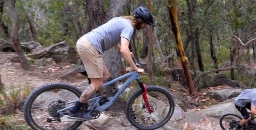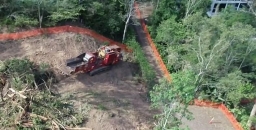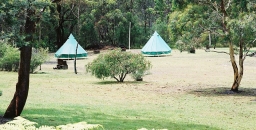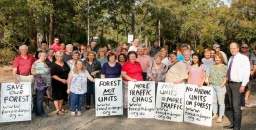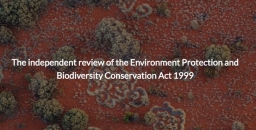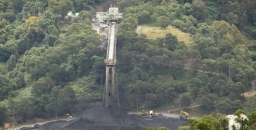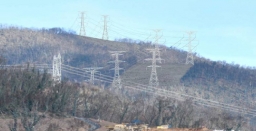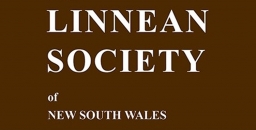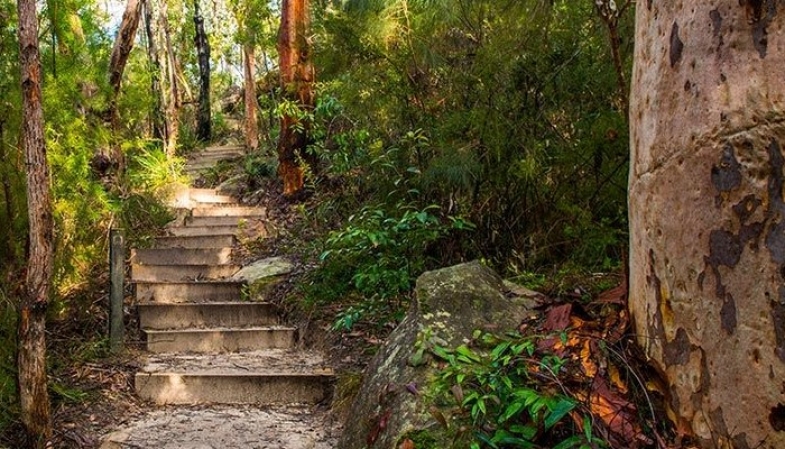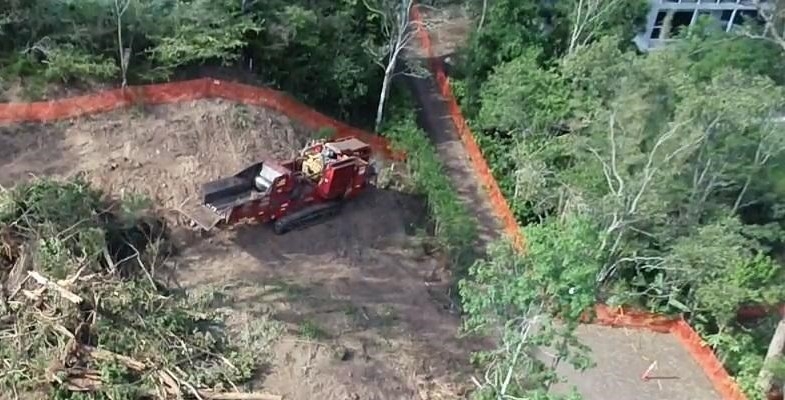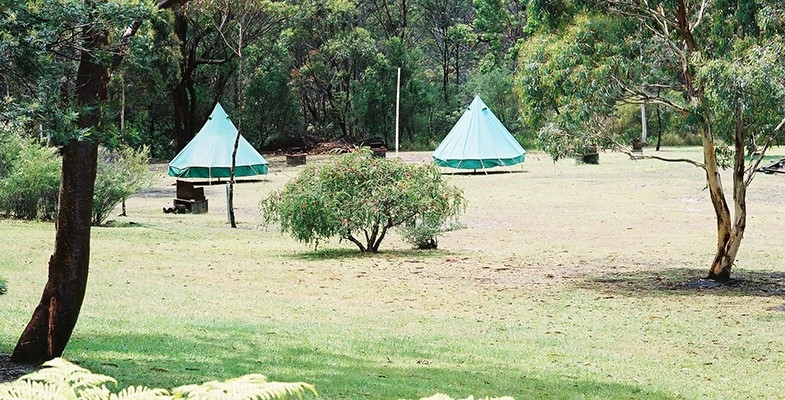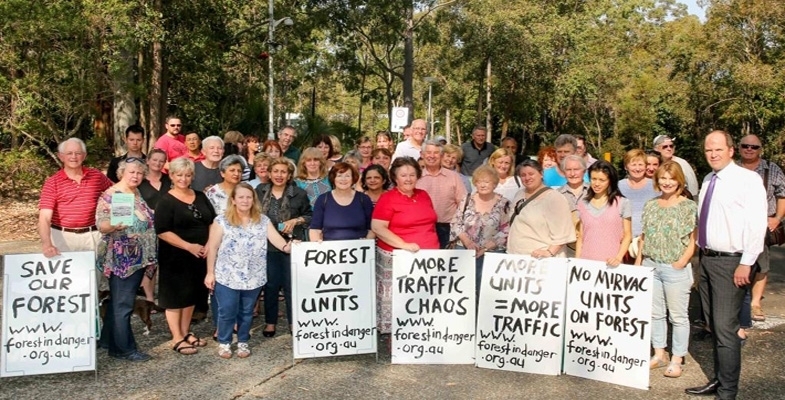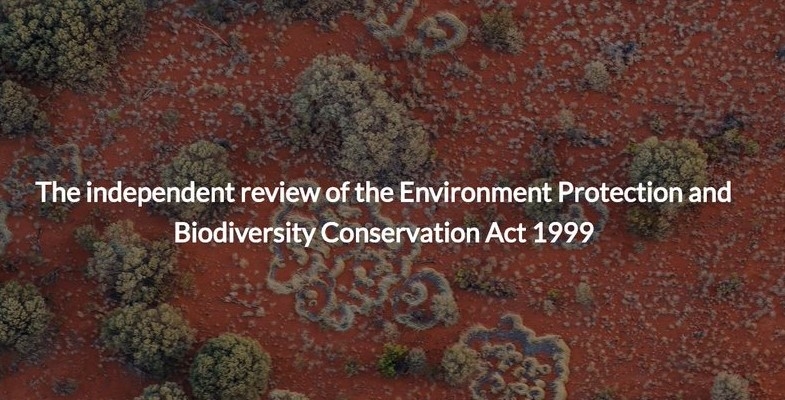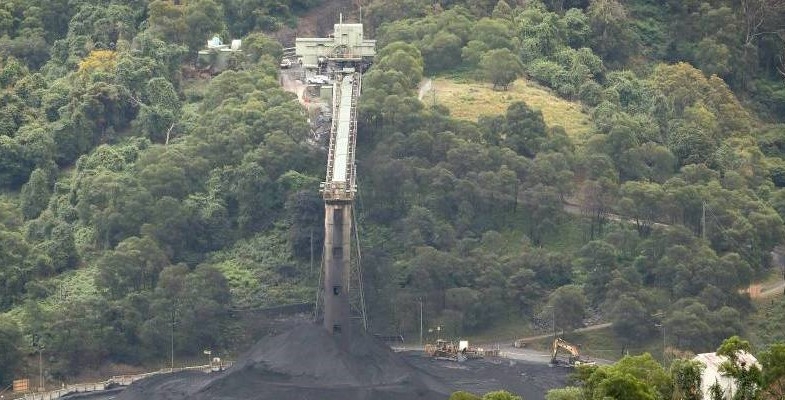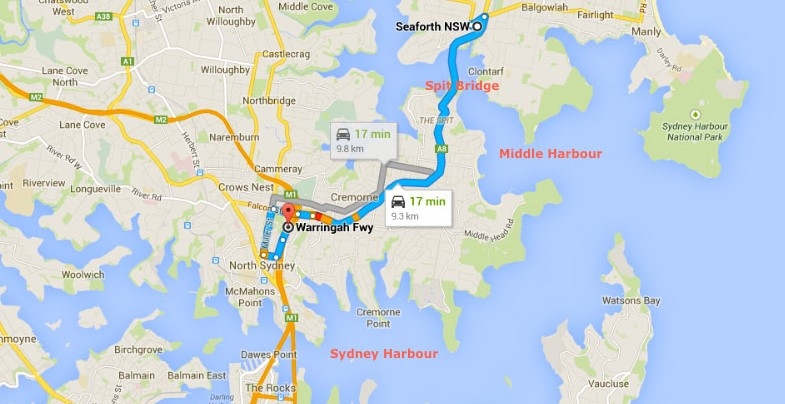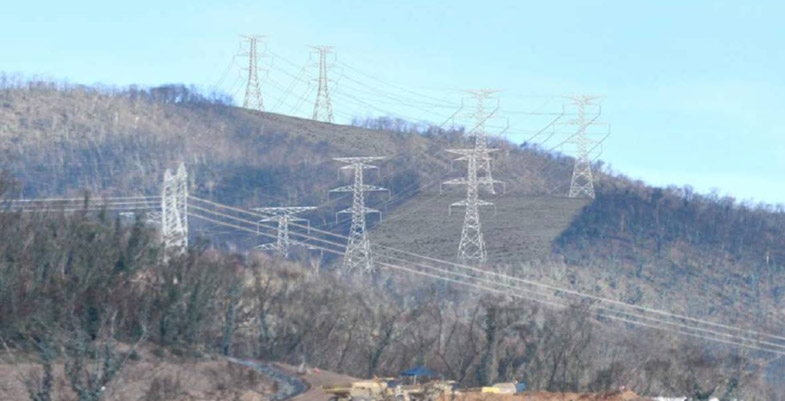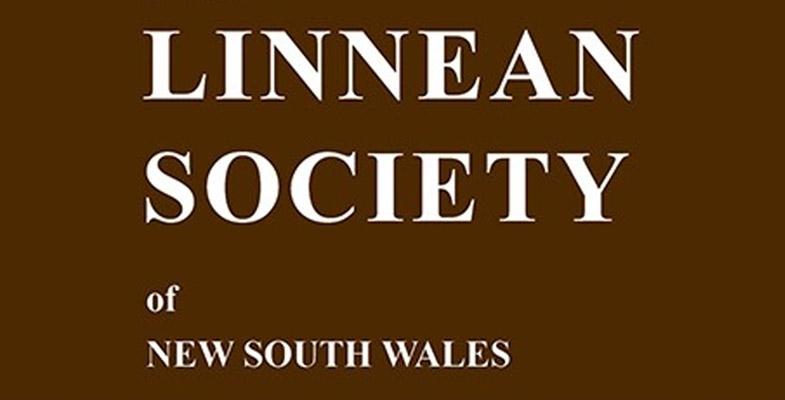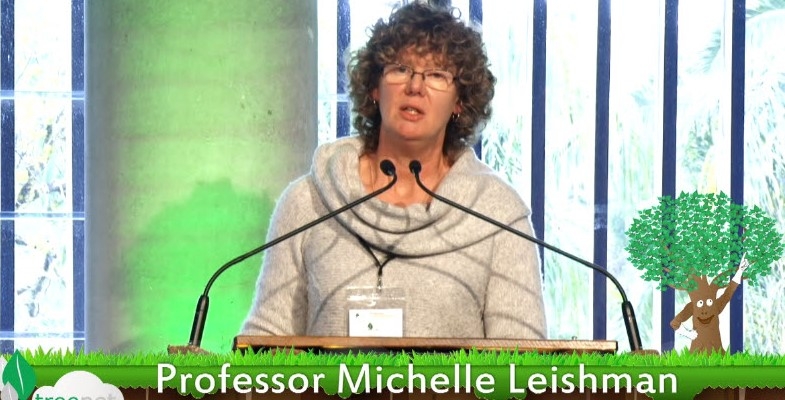STEP Matters 209
- Default
- Title
- Date
- Random
- In many areas of Ku-ring-gai people living near bushland have been busy constructing bike tracks for their family and neighbours…Read More
- In the November 2020 newsletter we explained concerns about the proposed change to land clearing regulations that would allow landowners…Read More
- In November 2020 we were alerted by residents of North Turramurra that the Glengarry Girl Guides site was up for…Read More
- The Mirvac development of the old IBM site next to Cumberland State Forest in West Pennant Hills was fast-tracked by…Read More
- The North Connex Tunnel that is a direct link between the Sydney Newcastle Expressway (now called the M1) and the…Read More
- The final report on the review of the federal Environment Protection and Biodiversity Conservation (EPBC) Act headed by Prof Graeme…Read More
- There has been much relief that the Independent Planning Commission (IPC) has ruled against the expansion of the Dendrobium Mine…Read More
- The NSW government is ploughing ahead with plans to build the Northern Beaches tunnel link at great expense estimated at…Read More
- We previously wrote about the damage the Snowy Hydro 2.0 project will cause to the sensitive environment of the Snowy…Read More
- The Linnean Society of NSW was established in 1874 and is one of Australia’ oldest scientific societies. Their objective is…Read More
- The Clarke Medal is awarded each year for distinguished research in the natural sciences conducted in Australia and its territories.…Read More
Attempt to Legitimise Illegal Bike Tracks in Ku-ring-gai
In many areas of Ku-ring-gai people living near bushland have been busy constructing bike tracks for their family and neighbours to use. We are aware of these tracks in North Turramurra, East Lindfield and North Wahroonga and there are many more.
This is illegal! You cannot go onto public land and do what you like. That is just like setting up a coffee shop at the front of your neighbour’s house and then dumping the rubbish in their garden.
These tracks can do tremendous damage to bushland, for example:
- erosion and compaction of the soil that damages root systems and destroys micro-organisms that plants depend on, particularly orchids
- destruction of plants and animal habitat including threatened species
- introduction of weeds and fungal pathogens
- changing stormwater flow causing erosion
- disturbance to wildlife that are nesting or foraging nearby
The authorised Warrimoo track was constructed after detailed research into the appropriate route and suitable materials.
Ku-ring-gai Council is actively implementing its Recreation in Natural Areas Strategy which includes the closure of these unauthorised tracks. Council has the power:
- to issue a notice to stop work
- to issue fines
- to recover the cost of remediation works
- to take legal proceedings to restrain the unlawful activities
But it seems that some people think they are entitled to do what they like in the bush.
There is an online petition circulating at the moment trying to gather community support to persuade Ku-ring-gai Council to stop closing and taking down illegal bike tracks and rehabilitating the bush.
[Please also see update at end of story]
The introduction to the petition demonstrates the gall of the proponents:
Waterball Enduro Mountain bike trail has been in construction for over a year, has not damaged the beautiful surrounding bushland in any way and has brought together so many kids in the local community in its construction and use. It has had many hundreds of hours spent in its building, design and maintenance.

These photos clearly demonstrates the damage they are doing to the ‘beautiful bushland’. Actually it is blatant vandalism.
If you would like to express your views, please address them to Councillor Donna Greenfield who will be receiving the petition to save the illegal bike track. Her email address is This email address is being protected from spambots. You need JavaScript enabled to view it.. Also send your letter to Mayor Jennifer Anderson This email address is being protected from spambots. You need JavaScript enabled to view it.,au.
UpdateThe damage two bushland caused by the track builders in North Wahroonga has now been remediated by Ku-ring-gai Council. There is still a lot of work to be done in other sites.
Coalition Against the Lane Cove Valley Freeway 1988 to 1995: An Amazing Community Achievement
 The North Connex Tunnel that is a direct link between the Sydney Newcastle Expressway (now called the M1) and the M2 was finally opened in December 2020. The occasion has caused several STEP members to reflect on the prolonged and passionate campaign that was undertaken to prevent the horrifying alternative proposals of freeway/s through the Lane Cove Valley bushland. The stories sent to us by Elaine Malicki, Pat Stewart and Caron Morrison are copied below, but firstly some background.
The North Connex Tunnel that is a direct link between the Sydney Newcastle Expressway (now called the M1) and the M2 was finally opened in December 2020. The occasion has caused several STEP members to reflect on the prolonged and passionate campaign that was undertaken to prevent the horrifying alternative proposals of freeway/s through the Lane Cove Valley bushland. The stories sent to us by Elaine Malicki, Pat Stewart and Caron Morrison are copied below, but firstly some background.
Background
A corridor had been marked on maps by the DMR since the 1940s for roads through the Lane Cove Valley between Pearces Corner and Fig Tree Bridge. Government attitudes at the time were that urban bushland was just vacant space available for utilitarian purposes. In the 1980s the word was out that plans were under active consideration for a freeway. The STEP committee was immediately on the case.
The August 1984 meeting minutes record a plan to alert residents, prepare a position paper and write to the Premier Nick Greiner. A sub-committee was formed that joined with other local groups. Walks were undertaken with photographers to illustrate what could be lost.
In early 1987 the NSW government’s intentions became clearer with the publication of a report called Roads 2000. A freeway along the valley seemed to have been abandoned but a link from Pearces Corner to North Ryde was still a possibility. This road may have been at least 10 years away but serious action began to try to nip this in the bud.
John Burke wrote a position paper that refuted the arguments for more freeways as well as highlighting the damage to bushland and neighbourhoods. On receipt of the paper Nick Greiner wrote a statement that that there was no intention of building a freeway.
But a change of government can change previous undertakings! Late in 1988 the prospects of a freeway became more serious when possible routes for a link were published by the RTA in a North West Sector Road Needs Study. The map shows the possible routes, dubbed the B2 and B3, that would have destroyed the tranquillity and environment of Wahroonga and South Turramurra.
Community groups were established such as the Coalition against Lane Cove Freeway (CALCVF) chaired by Elaine Malicki. The 1989 president’s report lists the massive amount of work carried out: public meetings, meetings with politicians, information papers, letters sent to media and politicians, members asked to write
Finally, in July 1995, the freeway corridor was abandoned.
That was not the end of the story as a further study by Sinclair Knight Merz on linking the F3 and M2 was made in the early 2000s. STEP employed a project officer, Kate Read, who wrote a paper that was submitted to SKM by STEP. It demonstrated that a link road would be a short-term fix unlikely to solve the transport problems in the longer term. This was followed up with lots of lobbying. The outcome was the recommendation for the tunnel that was built.
Postscript
The South Turramurra land that was in the B2/B3 corridor (Chisholm St) is now a residential area and other parts remain as bushland. The land between Eastbourne Ave and Fox Valley Road parallel to Lucinda Ave is still in government hands. Most is zoned as E2 and can’t become residential. Some near Fox Valley Road is zoned as E4 but has Blue Gum High Forest vegetation so we hope it can be maintained as green space.
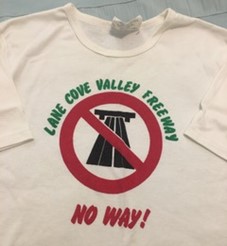 Elaine Malicki
Elaine Malicki
My documentation has been passed on to historical groups but would like to share what I see as the reasons for the strength and success of this campaign.
The initial meeting was called by the oldest community group in the area, the Kissing Point Progress Association. The meeting was held at the Kissing Point Sports Club and was very well attended, with representatives of the Kissing Point Progress Association, Ku-ring-gai Ratepayers Association, STEP (as it was then), a range of sporting groups, scouts and guides, local P&Cs, churches, kindergartens and environmental and bushcare groups. The Fox Valley area was involved as well as parts of Wahroonga, South Turramurra and West Pymble.
As locals we were very committed to opposing the plans for every freeway option.
At CALCVF’s initial meeting I was elected president and Tony Morrison was to be secretary, with a bevy of committee members from many different groups and this network became an essential part of our communication strategy and provided an army of helpers. My role as secretary of the Ku-ring-gai Ratepayers’ Association meant I had strong links with Ku-ring-gai Council (which opposed the freeway options) and the media.
Meetings were frequent and well attended. We resolved to provide regular newsletters to inform the community, and to seek and encourage media attention at all levels to both inform and pressure politicians. Community appeals for donations kept us in stationery and paid postage. We kept strong records and researched as much as possible. Every available document was scrutinised and contacts cultivated within the various departments involved with the decision-making as well as National Parks and Ku-ring-gai Council who were the custodians of most of the land involved.
Politicians were approached both en masse using Greg Bloomfield’s Votergrams, and through frequent letters to every MP. Every response was followed up and as many politicians and media as possible were asked to join us for a bushwalk to view the valley or to receive a briefing.
Public meetings were held at critical times to muster support and were open to all. It became our practice to invite any other freeway action groups who quickly became part of our network, e.g. LEN (Less Expressway Noise) from the vicinity of the newly opened F3 Freeway commencing at Wahroonga.
We shared information, supported and demonstrated for other groups and ultimately were similarly supported. I think it is fair to say
that CALCVF initiated this intense networking concept and it was highly successful.
Committee members worked to their strengths and the energy was extraordinary. Availability varied and people stepped up to fill gaps or to provide expertise or information or help. I resigned in 1991 to become a council alderman and my role was taken over wonderfully by Pat Stewart with Tony Morrison’s wife, Caron, becoming a linchpin of the group. The research and networking were second to none and persistence, knowledge and accuracy were central.
Bob Carr announced in 1995 that the B1, B2 and B3 freeway corridors were to be abandoned. It had been a long, intense and successful community campaign with a core of inexperienced mums and dads whose dedication saved the Lane Cove Valley for the future.
We worked together so well, with such a strong common objective, and we had fun too! This was the greatest achievement of my life (family excluded!) and I am sure many of the others felt the same. To have been part of saving our special valley for future generations was a marvel to me. It mattered ...
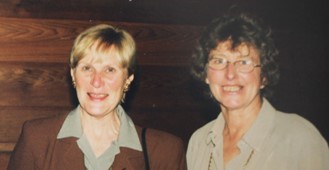
Elaine Malicki and Pat Stewart
Pat Stewart
I was president of CALCVF from 1991 until 1995 when the plans for the freeway were abandoned. Many people had worked hard and played an important part in the establishment of CALCVF before I joined the group and it was, indeed, a vital energetic group.
My most vivid memory of the long journey was the amazing committee that I worked with. The dedication of the people involved and the knowledge and skills that they possessed as well as their willingness to be called upon (often at short notice) to walk with, and talk to, politicians and other officials about what would be lost if the freeway went ahead. It was a privilege to know them.
I lived in Leuna Ave at the end of The Broadway Wahroonga, a historic roadway. This fascinated me. I began to clear sections using hand tools and I researched the style of road building and realised it was a Telford road. There are very few Telford roads remaining in Sydney. Further research revealed that it was part of a roadway planned by John Bradfield to join the northern roadway area to the Sydney Harbour Bridge. I also found that John Bradfield had been president of the Lane Cove River Trust and he wanted to retain the natural beauty of the area so I felt that should he be alive – he would find an alternative solution to the freeway.
When I became president I decided to focus on making all members of the NSW parliament aware of what would be lost if the freeway went ahead. I was lucky that Caron Morrison agreed with me and was prepared to work with me. Caron was familiar with the ins and outs of politics – she knew who we should focus on and she was prepared to keep them up-to-date with matters pertaining to our cause. Caron would regularly go into Parliament House to talk to parliamentarians personally.
I wrote letters to all parliamentarians addressing each individual letter and signing them personally. I invited them to come and see the area for themselves and members of our committee would meet them and talk to them and take them for a walk along part of the proposed route of the freeway. Quite a few parliamentarians and bureaucrats accepted the invitation.
Neroli and Harry Lock who lived in Leuna Ave would take us on a short walk to a large rock that gave a view over the valley and from there it was possible to see how much bushland would be lost.
We also kept the local people informed about the situation with letterbox drops and information tables at the local shopping centres.
We needed money from time to time to cover expenses. Our fundraising activities were kept to a minimum but one that still brings a smile to my face was one initiated by Neroli Lock. Neroli used her creative ability to print ‘money’. The ‘money’ was a larger size than the legal tender but it was an ‘investment in protecting the bushland of the Lane Cove Valley’. There were $2, $5 and $10 notes. These notes were different colours. When the idea was suggested to me, I went to her house to see what she was actually meaning and there – hanging on the clothesline were all these ‘notes’. ‘Laundering money’ certainly took on a new meaning.
All ‘investments’ (donations) were given with a chuckle. (I kept mine for many years.)
When it was announced that the freeway was not going to be built, we were elated. All the efforts of all the people involved had been worthwhile!
Although the announcement had been made, we knew that we had to continue our efforts to ensure that subsequent governments could not reverse the decision. It was not until the official
notice was published in the Government Gazette that we relaxed and felt that the group had really achieved an amazing result.
In summary, it looks like it was a simple easy thing to do – in reality it took a lot of effort by many people. It consumed years of my life.
Personally, I only fully relaxed when the tunnel was officially opened. It had been a long journey for many. John Burke, Elaine Malicki, Bruno Krockenburger, John Martyn, Neroli and Harry Lock all played a major role in this quest.
Stopping the building of the Lane Cove Valley Freeway was absolutely a magnificent accomplishment. Congratulations to everyone involved.
Caron Morrison
Psychologists say that the promises you make to yourself, especially when you are a child, are the most important commitments of all.
In 1964 my family moved from the centre of Sydney to the wilds of South Turramurra. After a life of traffic and bustle it was a strange and exotic land, full of the promise of adventure and mystery. Almost simultaneous with my arrival I witnessed the earth scarring destruction of the valley for the construction of the Comenarra Parkway. Whilst watching the intruders going about their business I made a silent vow that if I was ever in a position to prevent another road being built, I would do whatever I could.
Making this decision settled my mind but I can honestly say that I never really thought I would be in the position of having to act upon it. By several twists of fate however, I found myself as a young parent of four boisterous sons living once again on the edge of the valley and in 1989 the unthinkable happened. The NSW government decided, after decades of inertia, to build another massive road to connect Ryde Road with Pennant Hills Road and I was driven to almost manic levels of activity.
Since then, I have often wondered whether that level of activity was necessary, or whether I was just acting out following my childhood experiences but I genuinely believe that nothing short of a super human effort is required when you are up against the full might of government.
It would be easy to say that the period between the government announcement to build in 1989 and the decision not to build in 1996 was completely awful, but I value the opportunities to meet and work with some fascinating people in ways that I think led to great outcomes, even if I was ridiculously tired and stressed most of the time. I am incredibly proud to have been able to contribute in some way to the preservation of this unique treasure.
Bushfire-prone Land Clearing Rules
In the November 2020 newsletter we explained concerns about the proposed change to land clearing regulations that would allow landowners to clear within 25 metres of boundary fences without obtaining consent. This could lead to large areas of peri-urban rural land on smaller blocks being cleared. This was not a recommendation of the bushfire enquiry.
After lobbying by concerned residents Hornsby Council passed a resolution to write to the government requesting an exemption for rural-zoned land in the council area. Mayor Philip Ruddock said that the rural boundary clearing code could potentially result in the clearing of 1035 hectares, or half the vegetation on rural-zoned lands within the local government area.
In response, the NSW government agreed to exclude Sydney's councils from new land-clearing rules that would have given residents much greater freedom to cut down trees on their properties.
The final details of the code are being discussed. It is understood that Matt Kean and Planning Minister Stokes are pushing for curbs to avoid the destruction of endangered ecosystems, including koala habitat. We don’t want to see the indiscriminate clearing that is still occurring under the 10/50 code.
Concern about Sale of Glengarry Land
In November 2020 we were alerted by residents of North Turramurra that the Glengarry Girl Guides site was up for sale. The site covers 8.1 hectares and is zoned RE2, private recreation.
From the Miowera Road access the site is fairly level with a large hall, commercial kitchen, accommodation, multi-purpose cottages and rooms as well as outdoor recreation spaces. The rest of the site is high quality bushland on a steep slope that is bordered by the popular Glengarry fire trail and Darri walking track.
The bushland portion contains significant habitat elements such as hollow bearing trees, rocky outcrops, major creek lines and riparian zone that would cater for a diversity of native fauna species including threatened species such as the Powerful Owl. Walkers in the area have observed Lyrebirds, numerous small birds and seasonal visits by Goshawks. As the land has been privately owned there has not been any detailed ecological survey.
This land was donated to the Girl Guides in the 1930s for community use. They own two adjoining blocks to the north that were also donated to the Guides and are held under a Reserve Trust. They are zoned E2 and link to Ku-ring-gai Chase National Park. The whole sequence of blocks is part of the Cowan Creek Reserve of high biodiversity value.
In December the Girl Guides announced that:
The Board has approved the purchase of Glengarry by the preferred party and contracts have been exchanged. The purchase exhibits benefit to our Association, residents, and the community at large and includes a licence agreement of six years’ access for Guiding.
The purchaser is a community organisation. Their identity has not been disclosed. There's a big risk the purchaser may try to rezone the land for housing. (This happened to other Girl Guide owned land in Miowera Road in 2010.)
In STEP’s view any increase in population should not occur in this bushfire prone and high risk bushfire evacuation area. It could also be used for recreational purposes that would be detrimental to the ecology of the bushland.
We will be watching developments closely. Please alert us if you hear anything.
Update on the Mirvac Development in West Pennant Hills
The Mirvac development of the old IBM site next to Cumberland State Forest in West Pennant Hills was fast-tracked by the NSW government in June. The project is now proceeding at full speed. STEP is a member of the Community Reference Committee that has been set up by Mirvac. We are able to receive the details on the evolution of the project.
The DA for demolition was submitted to the Hills Council in December. This confirms that over 1,200 trees will be removed to make way for the residential development site including Blue Gum and STIF vegetation. This is the tree destruction that led to the huge level of opposition from the local community.
The next stage is the submission of the Concept Masterplan DA for the apartment and house developments. The original plan was for 600 dwellings, 400 apartments and 200 houses. This has been reduced to 450, 280 apartments and 170 houses in response to the Department of Planning requirements for Asset Protection Zones and protection of sensitive vegetation. This may change when the DA is submitted.
The number of apartment blocks has been reduced from nine in the original plan to alternative options with seven or four larger blocks. There is the possibility of some sections being up to nine stories. This exceeds the usual height limits. The argument is that the sight lines to the forest will be improved. We await the detailed DA for more information.
The forest area to be dedicated to the management of NSW Forestry as part of Cumberland State Forest has been increased to 10 ha. Mirvac will contribute some of the management costs. This will not occur until the DA has been approved and the subdivision process completed. It is still not known what will happen to other E2 (conservation) zoned areas.
Government Response to Samuel Review of the EPBC Act is Pathetic
The final report on the review of the federal Environment Protection and Biodiversity Conservation (EPBC) Act headed by Prof Graeme Samuel was released by the Environment Minister, Sussan Ley, in January, 3 months late. The report gives a scathing assessment of the implementation of the current Act. It ‘is not fit for current and future environmental challenges’. Sadly, but not unexpectedly, the government’s response does not provide promise that decisive reform will happen.
The main recommendations are for:
- strong, outcome focussed national environmental standards to guide decision making
- independent oversight by an Environment Assurance Commissioner and audit by an Office of Compliance and Enforcement to build confidence that the Act and the national environmental standards are working
- a mandated, rigorous compliance and enforcement regime to ensure compliance and enforcement of environmental approval conditions
- outcomes-focused law, which will require the capacity to effectively monitor and report on environmental outcomes
- adequate funding for species recovery and an environmental database such as mapping of habitat for threatened species to underpin decision making
- harnessing the knowledge of Indigenous Australians to better inform how the environment is managed
- recognition that environmental protection under Regional Forestry Agreements is insufficient and the need for immediate reform and Commonwealth oversight – a critical element to the ending of logging in the habitat of endangered species like the Swift Parrot
One controversial recommendation is to hand over approval powers to the states but subject to observance of agreed environmental standards. This proposal was included in the interim report released in August.
In response, the government rammed through legislation to implement this proposal. Attempts by independents, such as Zali Steggall, to make amendments for the crucial new standards were ignored. It is now up to the Senate to improve the situation.
Setting standards
The centrepiece of Samuel’s report is the proposed new national environmental standards. These would provide clear grounds for drawing a line in the sand on environmental damage. Any new developments would need to be in places where environmental damage is avoided from the outset, with offsets only available if they’re ecologically feasible and effective. One of the many failings of Australia’s environmental laws is there has never been a point beyond which no further impacts are acceptable. This requires consideration of cumulative impacts in a regional context.
The proposed standards say there should be ‘no net loss’ of vulnerable or endangered species habitat, and ‘no detrimental change’ to listed critical habitat of a species or ecological community. But the data has not been updated for 15 years so who knows what the correct baseline should be.
The proposed standards were leaked on 12 February. According to the Sydney Morning Herald they are no different to the existing clauses in the EPBC Act and obviously don’t meet the recommendations of an independent review. For example:
- demands for ‘best available’ information becomes a requirement only for ‘adequate’ assessments
- the need to address detrimental cumulative impact is missing
- plans that ‘must be prepared and implemented to monitor and evaluate outcomes of actions’ is also absent
We hope that the states refuse to accept these standards. Matt Kean has already stated he wants the strongest environmental standards enforced with a strong environmental watchdog.
Accountability
The federal environment minister can make decisions with little requirement to publicly justify them. They must be open to public and robust scrutiny and explain how their decisions might affect environments and species.
Species recovery actions
The review report explained the initiatives that are needed and why. Basically, the evidence shows our biodiversity is in dire straits and lip service is being paid to calls for action. Australia has more than 1,900 listed threatened species and ecological communities, and most don’t even have active recovery plans. Ecologists will need to collect, analyse and interpret new, up-to-date data to make biodiversity conservation laws operational for most threatened species.
A report in the journal Conservation Letters in November 2019 found that annual spending on targeted threatened species recovery is around $122 million which is around 15% of what is needed to avoid extinctions and recover threatened species.
Regional forestry agreements
Many reports have been written about the shortcomings of the Regional Forest Agreements. Currently they do not ensure protection of threatened species and their habitats. Any reforms will be hard fought by the forestry industries and locally affected communities.
Prof Samuel noted that:
… governments should avoid the temptation to cherry pick from a highly interconnected suite of recommendations.
But this is exactly what the Morrison government is doing.
Dendrobium Mine Expansion Refused by the IPC
There has been much relief that the Independent Planning Commission (IPC) has ruled against the expansion of the Dendrobium Mine near Wollongong. The mine is under the Sydney water supply catchment metropolitan Special Areas where longwall mining has already caused subsidence in the surface above with significant environmental damage.
The extension would have allowed the proponent, South32, to extract an additional 78 million tonnes of coking coal from two new areas near the Avon and Cordeaux Dams during the period 2024 to 2048. The mining would have comprised 21 ‘long wall’ panels, 18 of which would have been more than 300 m wide. Most of that coal would be used in steelmaking here and overseas.
In summary the IPC’s ruling is that the proposed longwall mine design introduces uncertainty regarding the extent of environmental impacts in the Metropolitan Special Area and the Applicant’s ability to adequately manage those impacts and ensure their statutory purpose is achieved; that is providing a supply of clean drinking water.
Some more detailed reasons for the decision were:
- the risk of significant subsidence that would degrade 25 watercourses and swamps and lead to the potential instability and fracturing of up to 40 cliffs located above the proposed longwalls
- the cracking of the surface could lead to significant surface water losses into the groundwater system with detrimental impacts to threatened ecological communities such as upland swamps, and Aboriginal cultural artefacts and values
- the fracturing of rocks could contribute to increased concentrations of metals in water flowing into the dams that are part of Sydney’ water supply
- the impact of past and existing longwall mining in the catchment is estimated at 3billion litres per annum – the extension is likely to increase this loss
- uncertainty around managing mine water inflow (surface waters permanently diverted underground) after mine closure
The level of risk posed by the project has not been properly quantified and, based on the potential for long-term and irreversible impacts particularly on the integrity of a vital drinking water source for the Macarthur and Illawarra regions, the Wollondilly Shire and Metropolitan Sydney – it is not in the public interest.
The IPC noted the applicant has offered mitigation measures for remediation of selected key stream features, financial offsets for water losses and water quality impacts and an upland swamp offset site; however, a number of these measures have not been considered acceptable by the responsible statutory agencies. How can it be possible to quantify the cost of irreversible and continuing loss of water or the value of a threatened upland swamp that cannot be replaced? How much more desalinisation capability would be required?
The Planning Department had recommended approval but as usual, they did not take into account cumulative impacts when added to the impact of the existing mines.
The Deputy Premier John Barilaro condemned the decision claiming a massive loss of jobs and investment uncertainty. One of the IPC’s considerations was that the bulk of this coal is primarily destined for other markets beyond the Illawarra Region, so we can’t take Barilaro’s scaremongering seriously.
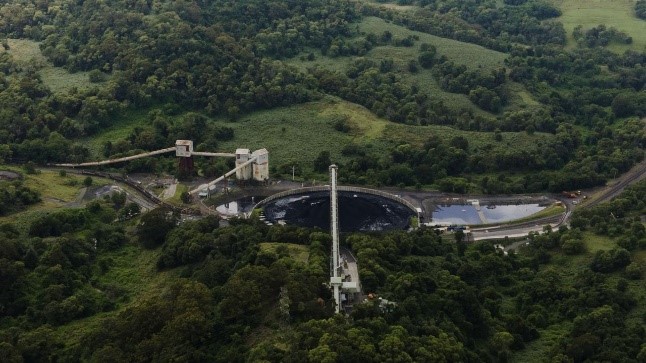
Northern Beaches Tunnel: Is there a better way?
The NSW government is ploughing ahead with plans to build the Northern Beaches tunnel link at great expense estimated at $14 billion. The massive EIS was released in December, just in time for Christmas. Submissions close 1 March. Click below:
The Beaches Link and Gore Hill Freeway Connection project, its full title, comprises a new motorway tunnel connection across Middle Harbour from the Warringah Freeway and Gore Hill Freeway to the Burnt Bridge Creek Deviation at Balgowlah and Wakehurst Parkway at Killarney Heights. The total tunnel length will be 5.6 km.
The crossing of Middle Harbour between Northbridge and Seaforth would involve three lane, twin immersed tube tunnels. The project also includes a surface upgrade of Wakehurst Parkway from Seaforth to Frenchs Forest and upgrade and integration works to connect to the Gore Hill Freeway and Reserve Road at Artarmon (see map at the bottom of the page).
The project will have major impacts on reserves and golf courses that will be used as construction and tunnel dive sites. Filtration vents will be close to schools. Then there will be all the traffic disruption over more than 5 years as the links are constructed and the tunnel waste is removed.
We have changed our ways of living and working in response to the COVID pandemic. As is happening all over Sydney, population increases are planned for the Northern Beaches but how many of these new residents want to commute to the city? Will they work within the northern beaches peninsula or want to travel west via Mona Vale Road?
The increased traffic along the proposed road will spill out near the Northern Beaches Hospital. Then what? Increases in congestion along Warringah and Pittwater Roads no doubt. The project will only encourage more road use as well as many longer term consequences.
There will be increased traffic along Wakehurst Parkway because it will lead directly into the new tunnel. But that road floods frequently. Will there be pressure to extend the widening of the Parkway? Yet this road goes through more high quality bushland.
So do we need to rethink this massive road project? Tolls will have to be increased to help pay for all this. Are there better alternatives? What about boosting public transport instead!
The Willoughby Environment Protection Association has discussed in detail whether public transport options have been given adequate consideration.
Another group, called Viable Transport Solutions has lots of information on their website.
Environmental impacts
Once again bushland is deemed to be expendable. The Wakehurst Parkway from Seaforth to the Northern Beaches Hospital would be widened to two lanes each way with most of the bushland clearing occurring on the Manly Dam catchment side. Garigal National Park on the west side will also be affected, especially during construction. Could there be a viable alternative of extending the tunnels to reduce the damage to the bushland?
The current proposal entails the clearing of 15.44 hectares of native vegetation, much of which is threatened species habitat, adjoining Manly Warringah War Memorial Park that protects the waters of Manly Dam. This includes about 2,000 mature trees.
1.38 hectares is consistent with the Duffys Forest Ecological Community in the Sydney Basin Bioregion (listed as endangered under the Biodiversity Conservation Act). A large area of Duffys Forest was also removed for the road widening around the Northern Beaches Hospital. More cumulative impact being ignored!
Overhead ladders and some tunnels will be built to provide wildlife corridors across the Wakehurst Parkway. Funding will be needed to observe their effectiveness.
The EIS says biodiversity offsets for native vegetation would be provided for the project. Of course they can never make up for what will be lost. Where can suitable offsets come from? They can’t be in national parks.
The list of other negative environmental impacts is long; for example, pollution entering water courses and groundwater that will affect water quality in Manly Dam, Aboriginal heritage along the Engraving Track, air pollution from traffic and tunnel emissions.

More Bad News About the Snowy Hydro Project
We previously wrote about the damage the Snowy Hydro 2.0 project will cause to the sensitive environment of the Snowy Mountains National Park. The EIS in relation to another aspect of the project has been released covering the transmission of power to the electricity grid.
Snowy Hydro has chosen the cheapest and most environmentally destructive option by proposing overhead transmission lines. The impacts of overhead transmission will include:
- permanent disturbance to wildlife habitat by clearing 100 ha (8 km of clearing up to 200 m wide) of national park under the path of the powerlines
- ongoing cost and disturbance when the land clearing has to be renewed
- loss of native fauna including threatened species such as the Yellow-bellied Glider, Eastern Pygmy-possum, Squirrel Glider, Gang-gang Cockatoo, Powerful Owl, Masked Owl and Booroolong Frog
- land disturbance including erosion and weed infestation
- the lines will be visible over a vast area, totally destroying the ambience and habitat integrity of this remote and largely pristine region
These are irreplaceable ecosystems in the middle of Kosciuszko National Park, they will not recover, and they cannot be offset, these are natural areas set aside for conservation and future generations, not for development.
These powerlines should be put underground.
Click here for more details from the National Parks Association about why Snowy 2.0 doesn’t stack up.
Please write to the Environment Minister Matt Kean and Planning Minister Rob Stokes to express your views.
Photomontage at top of page by Transgrid, Lobs Hole, Kosciuszko National Park
The Linnean Society's Symposium
 The Linnean Society of NSW was established in 1874 and is one of Australia’ oldest scientific societies. Their objective is to promote 'the cultivation and study of the science of natural history in all its branches'. Associate membership costs $15 per year.
The Linnean Society of NSW was established in 1874 and is one of Australia’ oldest scientific societies. Their objective is to promote 'the cultivation and study of the science of natural history in all its branches'. Associate membership costs $15 per year.
The topic for their next symposium is Natural History of the North East Sydney Basin. This covers the area bordered by the coastline, Sydney Harbour, the Hunter Valley and the westerly national parks, Berowra and Marramarra. The focus will be on the geology, botany and zoology of the national parks and other reserves, inlets (e.g. Broken Bay), central coast lakes and sea cliff features.
Call for papers
Anyone conducting research into any aspects of the natural history of the North East Sydney Basin, be it formal studies or citizen science, is invited to present their results at the symposium. Aspects of planning and management related to environmental matters can also be covered.
Papers will be subject to the normal refereeing procedures of the Society and will be published in the Proceedings.
To indicate your interest contact Mike Augee (symposium secretary) This email address is being protected from spambots. You need JavaScript enabled to view it. or 89 Caves Road, Wellington NSW 2820.
Program
Wednesday 27 and Thursday 28 October
Symposium with scientific talks (both technical and popular) at Hornsby RSL.
Cost: $70/day ($100/day for non-members). After 31 August costs $10 more per day. Includes lunch and refreshments.
Friday 29 October
Full day field trip by bus, centred on Ku-ring-gai Chase National Park (visiting West Head, Elvina Track and Bobbin Head, Gibberagong boardwalk), finishing up with an inspection of the diatreme face exposed in the Hornsby Quarry redevelopment (subject to access being permitted). Experts in geology, botany and zoology will guide the excursion. Numbers are limited.
Cost: estimate is $50 ($60 for non-members). Includes lunch.
Saturday 30 October
Special additional optional excursion (at no cost) for registrants only, walking the Newcastle Coastal Geotrail and guided by staff from the Geological Survey of NSW who have created this widely acclaimed tour. Intending participants will provide their own transport and food for this excursion.
Michelle Leishman Awarded the Clarke Medal
The Clarke Medal is awarded each year for distinguished research in the natural sciences conducted in Australia and its territories. The fields of geology, botany and zoology are considered in rotation.
In 2020 it was the turn for botany and the award winner is Distinguished Professor Michelle Leishman. Michelle was STEP president during the periods 1997–99 and 2000–06.
Her studies at the Macquarie University’s School of Biological Sciences are currently directed towards greening urban spaces through the Which Plant Where program such as cooling school environments, studying plant responses and adaptation to climate change and understanding invasive plant pathogens. We congratulate her for the significant initiatives that respond to the need to adapt to the long-term outlook for the natural world


